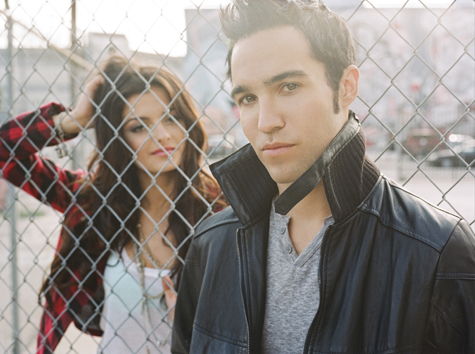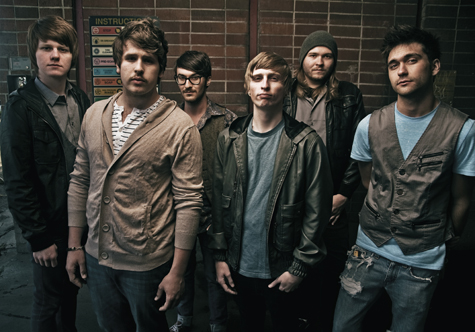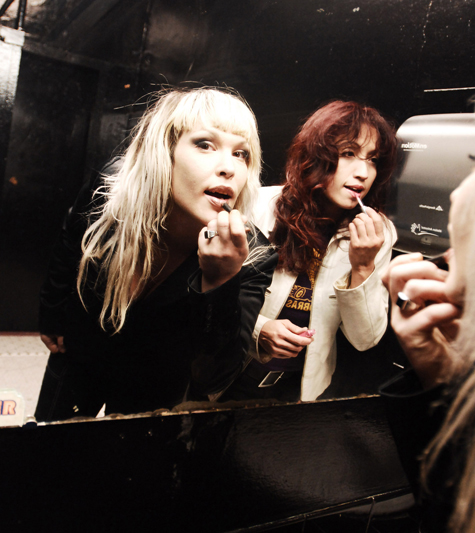Black Cards proves Pete Wentz has many tricks still up his sleeve
Pete Wentz has become synonymous with energetic, slightly emo pop-punk–not that there’s anything wrong with that. It’s not difficult to understand why. As bassist and lyricist for Fall Out Boy, Wentz helped pen songs such as “Sugar, We’re Going Down” and “This Ain’t a Scene, It’s an Arms Race” that propelled his band’s albums into top 10 rankings on the Billboard charts and garnered the band some hard-earned Platinum. Since 2009, however, Fall Out Boy has been on an indefinite hiatus, leaving Wentz to focus on other things, such as being a label owner, entrepreneur and father. Black Cards is Wentz’s first foray back into music since Fall Out Boy took a vacation, and taking his prior output into consideration, it would logically follow that his new band’s music would be reggae-tinged British-style electro-pop music. Wait…you mean it wouldn’t? Well, I don’t know what to tell you. That’s how this shit works out sometimes.
Wentz started Black Cards out of a desire to do something different. He said in a recent interview with Alternative Press, “I’ve watched people when their bands are on hiatus or whatever it is, and they have the itch to do something, but they don’t really do anything that differently. It makes it all the more easy for people to be like, ‘Well, why doesn’t he just do his [main] band, then?’” But the desire to do something people wouldn’t expect from you and actually pull it off are two entirely different things. Wentz had to go outside himself in order to make it a reality.
The first piece of the Black Cards puzzle was Sam Hollander. A producer and songwriter, Hollander has worked with a wide array of artists from Coheed and Cambria to rap group Arrested Development (he also worked with Gym Class Heroes, who were signed to Wentz’s label Decaydance). Wentz told Submerge that it was Hollander’s encouragement that got him into the studio in the first place post-Fall Out Boy.
“After FOB went on ‘hiatus’ I wasn’t really sure what I was going to do,” Wentz shared via e-mail. “Sam hounded me to come into the studio over and over, but I thought I wasn’t ready. He just convinced me that even if nothing came out of the process I should have a place to let out my energy. As soon as we got in the studio together, it felt right and Black Cards stemmed from that. Sam’s a good friend who knows how to spark my creative side without me even realizing it.”
This new “spark” urged Wentz down a decidedly different path. Instead of penning anthemic rock choruses, he was at work creating his take on Jamaican roots reggae mashed up with the electro pop sensibilities of artists like Lily Allen. Under the guise of Black Cards, he said he’d have the freedom to express things he may have not felt comfortable doing with Fall Out Boy.
“Well after doing something for a number of years–especially with people watching–things are expected of you, and I really feel FOB fans came to expect those type of lyrics and songs from us,” Wentz said. “With Black Cards I really get to start over, be all over the place and it’s OK. I hope fans just take to that and enjoy something new.”
Lyrically, Wentz was looking to get out of his own head. Fall Out Boy’s lyrics tended to be personal. With Black Cards, Wentz is able to look outside himself, and he said that the experience so far has been liberating.
“It’s fun to escape and just be creative,” he said. “You are always the party and everyone isn’t invited: that’s been a hard concept for me to understand. Sometimes I have to learn to give myself a chance to just be me and not worry so much if everyone else is doing OK.”
With a new direction musically and lyrically in place, Wentz needed to find a new voice. Enter unknown Staten Island, N.Y., singer/songwriter Bebe Rexha, whom Wentz heard singing by chance at Hollander’s New York City studio.
“It just clicked when I heard her singing,” Wentz recalled of his first encounter with the young vocalist. “I told Sam that she’s the one we had to work with.”Â
Wentz said that Rexha is sort of like his “battery sometimes.” Her youthful energy hasn’t been bogged down by years in the spotlight. Not only is she a fresh voice for Wentz, but a fresh perspective.
“It’s impossible for her curiosity and excitement about everything not to rub off on me,” Wentz explained. “I definitely feel like the big bro teaching her the ropes and she’s a sponge.”
Writing for a female vocalist also provides Wentz with a new challenge–albeit an enjoyable one.
“Its hard to picture myself outside of my own mind in general,” He said. “It’s especially hard to think as a girl from Staten Island. It’s been a fun challenge that is different than anything I have ever done.”
As of now, no release date has been set for Black Cards’ debut album. Though the band has unveiled a few songs here and there, including “Club Called Heaven” and its accompanying Bonnie and Clyde style video. Wentz has hinted in the past that the album is done, but it seemed from our correspondence that nothing is entirely set in stone just yet.
“Every day we think we’re finally done and every day we think of a way to make a line or melody better,” he said. “We’re still getting to know each other so we’re constantly finding differently ways to execute a lyric or switch up a beat. We just want to make sure the album is 100 percent what we want it to be so I can’t make any promises on when it’ll come out.”
Even the title is up in the air as Wentz said he comes up with a new title each day. However, given the serendipitous way Black Cards was formed, you should shed any expectations of how it should turn out and just enjoy the result, whatever it may be.
Black Cards will play District 30 in Sacramento on July 3, 2011. The event will feature a live performance from the band and a special DJ set by Pete Wentz. There is no cover charge if you arrive before 11 p.m., and drinks are also half-off before then. For more info, go to District30sacramento.com.
Tree House Dinners are Truly a Movable Feast
Words by Adam Saake – Photos by Debbie Cunningham
The sun went low, and at a touch before seven, a light breeze swept over the Midtown Victorian porch, cooling guests from the belated summer heat. Small, natural artifacts of sticks, kumquats, found rocks and candles were scattered on overhangs and railings. On a table in the corner, a bottle of Sommariva Prosecco was submerged in an ice-packed watering can and flutes were filled at leisure while brown paper bags of popcorn with fresh dill were passed around. A total of seven guests, strangers, were quickly sharing stories and salutations over ceviche and cucumber. This was the beginning of chef Kevin O’Connor’s underground dinner he whimsically calls Tree House.
“The name Tree House came to me at 4 a.m.,” says O’Connor. “Tree House evokes juvenile thoughts and I aim to do the same with my style of cooking.”
O’Connor himself might be the only thing juvenile about what goes on at Tree House (which by the way is at a table in his dining room). The talented young chef of Ella, and most recently its sister restaurant, The Kitchen, is a mere 22 years old. A clean-cut red head who looks more relaxed in a cut-off Iron Maiden t-shirt than he does in a chef’s coat, this cooking star in the making worked his way from dishwasher up–sans culinary school. As a teen, he hopped around different restaurants like Masque and Bistro 33, but things took a sharper turn when he moved downtown and began cooking at Mason’s, now Cafeteria 15L.
“I helped open MiX and shortly after the opening I moved to the South of France for a few months,” says O’Connor. “After culinary enlightenment dans la sud, I came back home to Sac and joined Kelly McCown at Ella shortly after he came.”
It was this trip to the South of France that would later become the inspiration for his monthly underground dinners.
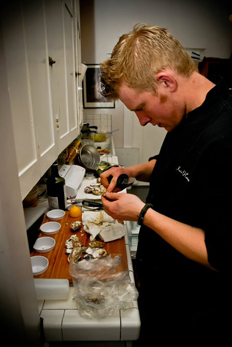
“Tree House began after I moved home from France. Every Sunday for a month and a half I would make dinner for my host family and their friends while I was in France,” O’Connor remembers. “These dinners were coursed out and showcased my creativity that was flowing while I was exploring food Mecca. I used produce from the farm, the town market, neighboring farms, hunting, foraging, and wine from their winery.”
The Tree House dinners are something to that effect, except O’Connor doesn’t have France or a farm–in spirit, sure, but he did have the winery this time. Craig Haarmeyer of Revolution Wines supplied all the wine pairings for the latest dinner, including the current vintage of their award-winning port.
Guests were leisurely enticed inside to sit at the table, well lubricated with Prosecco and conversation and ready for what O’Connor had up his sleeve. Once seated the night began with an amuse bouche, a small introductory appetizer that literally translates to “mouth amuser,” which consisted of prosciutto, pan-fried quail egg and a house-made hollandaise sauce. It was served simple and elegant in a Chinese ceramic soup spoon. Down the hatch. This single bite immediately excited the table and was a clear window into O’Connor’s cooking philosophy; one in which breakfast was clearly fair game for his introduction. Revolution’s Verdelho port, a sweeter white, paired beautifully, and we were on our way.
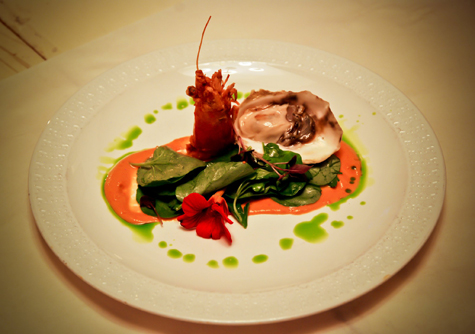
O’Connor’s plates have a touch of seriousness mixed with a pinch of brilliance and are lathered thick with humor. He grinned as he described courses like the pistachio encrusted foie gras with roasted peaches, calling his concoction “a foie gras candy bar.” His time in France came out in this dish too. He explained to the table one of the first and most memorable meals he had that was simply a bowl of pistachios, some peaches and a bit of foie gras. This was his translation–and what made each course so fantastic. He cooks off the pure joy of his memories with a little help from random musings.
“I’m inspired by the strangest things sometimes. A walk by the river, a 2 a.m. junk food binge, my food-filled childhood,” says O’Connor.
That “food-filled childhood” that O’Connor attributes to his father introduced a standout dish that was a play on mustard chicken. O’Connor’s father would make him a comforting plate of mustard chicken with a panko crust when he was a kid. To do honor, the most visually attractive plate of the evening arrived. Chicken rillettes with a half-moon toast was presented on a square, gray stone slab, dusted with an orderly stripe of honey mustard pretzels and garnished with a circle of pepper and mustard flowers. Rillettes is like a pate where the meat is slowly cooked in fat, duck fat in this case, and then is cooled and served like a spread. O’Connor “marinated the chicken, cured it for a day and braised it for about four hours,” to give it the texture and consistency he desired. This plate stood out the most and really showcased O’Connor’s creativity and technical execution.
An eight-hour sous-vide pork belly with barbeque beans, compressed watermelon and a salad of pickled watermelon rind (an ode to summer, perhaps) was followed by a simple offering of local goat’s milk cheese, Bing cherries and thyme flowers. Simple and to the point; elegant and delicious. Each course offered a new idea, an interesting thought or an adventurous leap to take (O’Connor encouraged guests to suck the brains from a fried prawn head during one course). The Tree House dinner finished with a mind blowing dessert course of cinnamon sugar toast, maple blueberries and a cereal milk anglaise for dipping that was inside of a hollowed-out egg shell. Guests enjoyed port to pair and moments of silence swept over the table as plates were literally licked clean.
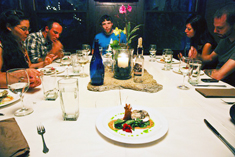
A satisfied Tree House assembly took refuge on the porch, enticed by 15-year aged Glenlivet scotch being poured from a transparent globe decanter. O’Connor emerged from the house, sans chef coat and ready to be part of the conversation. His left arm is tattooed with a crude chef hat, crossbones and knives with the mantra, “Cook to Live, Live to Cook.” “It’s being covered soon,” he said. But, there’s no hiding his passion for food and for the people he cooks it for. And as hidden as the underground dinners might seem, there is a Facebook page and O’Connor has special wording that keeps him out of trouble–for now.
“We aren’t a real underground restaurant…we are a ‘private dining cooperative’ where like-minded foodies pitch in for dinner that happens to be at a residence,” says O’Connor.
Where he takes these dinners is up in the air for now, but there’s talk of catering, pop-up events and cocktails in alleyways. Ideas are flowing and O’Connor’s love of Sacramento will keep him right here for those adventures.
“I’m inspired by the people that say Sacramento sucks and by the people that have faith in it becoming a food city at the same time. I want to start forming a Sacramento cuisine,” says O’Connor.
One Tree House at a time.
Tree House dinners happen once month at an undisclosed location in Midtown. For information on how to register, visit Facebook.com/treehousesacramento or Treehousesacramento.blogspot.com
Lee “Leecifer” Gajda brings paintings and his creepy vinyl friends to Dragatomi
During our interview, artist Lee “Leecifer” Gajda brings up what he says is an old adage regarding art. “You can buy it or make it,” he said. “But you can’t do both.” The adage held true for Gajda, and in a roundabout way it is what propelled him down the path toward vinyl toy customization, which is what has made him a force in the underground art world.
When we spoke to Gajda, he was at his home in Oakland, packing up his artwork (about 22 toys and 18 paintings in total by his count) for his current show at Contemporary Conflagrations, which is running now through July 19, 2011 at Dragatomi in Sacramento. The artist was chatty and instantly friendly over the phone. It was the sort of jubilant personality you’d expect from someone who spends his life doing what he loves. However, the life of an artist wasn’t always what Gajda thought he wanted, opting instead for a 401(k) and early retirement, he said. He spent years working as an art director for a phone company, but when a corporate merger would have forced him to move to Texas to keep his job, he bowed out of the corporate world.
“They had a job for me, but they had moved all the artistic services to Dallas or somewhere in Texas,” Gajda said. “I love the West Coast, man. Screw that.”
Gajda said he got on the vinyl toy “bandwagon” pretty early on, about eight or 10 years ago. It was even before Kidrobot, a store that is sort of a touchstone for the vinyl toy culture, opened its doors in San Francisco. Prior to venturing into toys, Gajda did some work as a gig poster artist for The Pine, a venue in Livermore, Calif. Through his gig poster work, he was fortunate enough to meet Frank Kozik. At Kozik’s home, Gajda got turned on to vinyl toys.
“I went to his house, and he had what would have at that point in time been considered the roots of the vinyl movement,” he explained. “He had a lot of Bounty Hunter and stuff from Japan. The first pieces I actually customized were pretty pricey stuff, which is actually funny because I wish now that I had a lot of that stuff back. You reach for the first thing you can in terms of painting, so I had picked up some really nice pieces over the Internet and proceeded to paint them. I sold them, and at the time it seemed like a good idea, but once you become a collector, you’re like, ‘Damn it! I wish I had that piece back.’”
It wasn’t just his encounter with Kozik that inspired Gajda to start customizing toys, but also his and his wife Michelle’s love for collecting art by Sam Flores, Jeremy Fish and others in the Bay Area underground art scene. However, when Gajda lost his job, it wasn’t economically feasible for the couple to drop over two-grand on paintings any more. They could, however, buy toys based on the works of these and other likeminded artists. It was this idea that anything could be a canvas that inspired Gajda to try his hand in painting toys.
“I thought, even before the first proliferation of heavy toy shows, these guys, their attitude is that they’ll paint anything,” he said. “They’ll go throw down on a big burner piece on a wall somewhere, or they’ll sculpt something, or they’ll have their own vinyl toy produced. No disrespect to them, but I saw it as a canvas.”
Gajda said part of the thrill was being a part of a scene that was just getting started.
“You could feel it growing locally,” Gajda enthused. “That’s why I have such an affinity with the toy thing. I got to see it start. How often do you get to be a part of a scene that gestates in front of you?”
The artist admitted that he’s not sure about the future of the vinyl toy movement. He questioned its longevity and also expressed concern over the carbon footprint of working with vinyl (i.e. that it’s shipped from overseas in most cases and how the waste materials from its production process are handled). For the time being, he’s happy where he’s at. He even has his own toy, a creature called Honoo the Flame, that has been produced by Super7. Gajda discusses his new show at Dragatomi and other developments in the following interview.
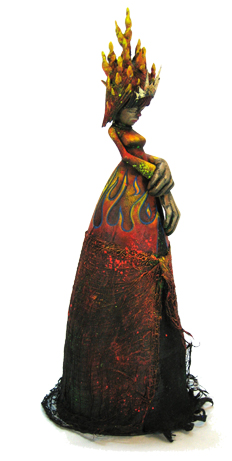
Honoo Queen Fatima
Has the carbon footprint aspect of the vinyl toys pushed you more toward conventional painting?
My focus…my future is going to be producing art. I don’t want to go back to a corporate job. My skill set now could easily be replicated by a kid coming out of college who’s going to work twice as hard, be less bitchy, have all the current applications under his belt and be willing to work for half the price of what I would want. So I’m kind of screwed as far as getting a corporate job goes. At this point too, I’m covered in tattoos. I like my cocktails. I’m not the corporate material I might have been once upon a time. I really enjoy making art, and I’m happy that people are buying the paintings. I’ll continue to do toys as long as they’re around, and hopefully that will be a long time. The show I’m doing at Dragatomi, I think, has a nice blend of both…
The show you’re having at Dragtomi is called Contemporary Conflagrations and its logo is an image of the Honoo character. Is that the centerpiece of the exhibit?
Oh yeah. The show is based around the release. When you finally get your own toy, you want to share it with your friends. I’ve gotten to work with the Dragatomi folks for some time now, and I immediately thought it would be really cool to have a show and a release at their toy store. I’ve done a few group shows since the release of the figure, and in some cases, I put flames on all the toys. In this case, I didn’t do it as much. I was looking for a specific image or feeling for each toy. I didn’t just liberally apply the flame motif to everything.
There are a bunch of little paintings that are shots of the Honoo. The bigger images don’t have the Honoo at all, and the toys, I did a half-dozen Honoos, but it’s a pretty nice mix. I didn’t want people to walk in–specifically the kids–and see all these horrifying toys on fire. It’s an all-ages show. There’s no nudity, no flaming penises.
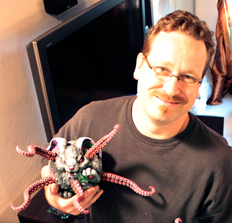
No flaming penises? Not even one?
I’ve been known to toss a penis in periodically or a good female genitalia, but no, there are no genitalia in this show, and even if there was, none of it would be on fire. I think we have a nice mesh of art for folks to check out.
Were the Honoo something you created or something taken from folklore?
To my knowledge, it’s something that I created. I might have borrowed liberally from folklore, but off the top of my head, it was unconscious if I did so. I gave it a background story so it would mesh with the rest of the Monster Family toys. Super7 had been making their own product for quite some time, and Brian Flynn is just an amazing designer, just a master of his craft. They’ve made some incredibly wonderful toys. They were working with a lot of the people in the vinyl toy scene who’d already had toys. With the Monster Family line, they’re working with folks who’ve never had a toy, or American artists, or people who are on the fringes of what would be considered the vinyl scene but still very relevant in the underground world. It’s just really great. Some of them are well known people like Kathie and Brandt [artists Kathie Olivas and Brandt Peters]…you’d have to look them up online to get everybody. But there was a few dudes who’d never had a toy, myself included, which was really killer…
It takes quite a while from start to finish to get a toy made. It took more than a year, and we had talked about it a year before that. They make a sculpt, they make a master mold, then I think they make a metal mold and pull the vinyl. Then they make a paint mask and actually paint it. It’s quite a process.
It sounds like it would be, to go through production and manufacturing.
Yeah, for just one little toy, it’s kind of crazy, which is why the collectibility is so high. The way Super7 does it, they produce in really small runs and small quantities. This isn’t about trying to make a dime. This is about trying to make a superior quality piece, and I think they’ve done that successfully, which is why I was excited about getting the opportunity to work with Super7. The first color wave sold out remarkably fast, and the second one has as well. I think it’s been well-received. My concerns were that they’d languish on the shelves forever and ever. The interesting thing is that the flippers haven’t gotten to them yet. People are saving them for their own collections. I haven’t seen a single one on eBay.
Another thing that happened, the larger sculpting community turns their nose up at people customizing toys. They think if you’ve taken something out of circulation, you’re limiting people’s ability to get their hands on it. But I’ve always felt that they’re toys, you can do whatever you want to them. I love the customizing aspect. There are dozens of dudes who are producing all kinds of radical reinterpretations of art. The first thing I did when I got my own toy was put my money where my mouth was. I invited everyone to buy them and fuck them up as much as they wanted to. Go nuts! Paint them. Some of the toy heads flashed me the middle finger on that one, but my friends just went nuts. Lots of customizers bought these things up. I don’t know how many of the original two color waves are left. They might be a rare collectible at some point just because everyone’s painted them.
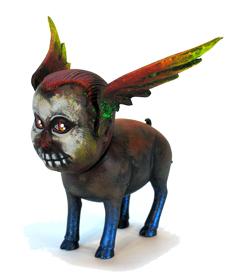
The Harbinger
One other piece, I saw it on your blog, it’s like a pig with a human head and wings on the ears. Is that part of the exhibit?
Oh yeah, that’s Jermaine Rogers’ Squire. There’s a funny story about that piece. That particular one is about 5 or 6 inches wide, and maybe 3 or 4 inches tall. They made a few fiberglass ones that are larger than, or about the size of a real dog. Scaled up, that head is three or four times human size. It’s a really creepy piece. We were lucky to get one from Jermaine. When my in-laws saw it, they were like, “Holy Christ! Who put Bill Clinton’s head on a dog’s body?” I guess when you scale it up it does look sort of like Bill Clinton. We’re calling that piece The Harbinger, I think.
Leecifer’s Contemporary Conflagrations is open now through July 19, 2011. While you’re checking out his work, look for the rare Propane/Dragatomi Blue Honoo figure, which is sold out everywhere else, but now available at Dragatomi. Go to Dragatomi.com for more info.
Every Tuesday night through August, Mix Downtown located at 1525 L Street will host Jazz in the Mix in their fantastic rooftop lounge setting. Starting at
6 p.m., hostess Ava Lemert, known as “the Singing Saxstress,” will start things off, eventually making way for the night’s featured act, which will rotate every week. Regional jazz greats Cynthia Douglas (June 14), Caribbean Jazz Collective (June 21), Nagual (July 5), Tony Elder (Aug. 9) and many others will fill the air with music while patrons enjoy elegant cocktails, wine, beer and delicious small plates. Things wrap up by 9 p.m. for those who have to work the next morning, so don’t let that keep you from coming out. Visit Jazzinthemix.com for more information, a list of all headliners and links to their websites.
The Pride of Lodi, In Oceans Prepares to Play Sacramento
Before the progressive rock group In Oceans starts band practice, they prepare to embark on a mini journey. All six band members pack up their instruments and meet at a cottage, located in the “boonies” to get the creative juices flowing. While jamming in the small cottage, the band has turned their random guitar strums, bass notes, drumbeats and song lyrics into music that can make anyone want to jump around in a mosh pit.
The Lodi, Calif.-based group is ready to share their five-song EP Earthwalker with music fans everywhere. Submerge caught up with vocalists Stephen Parrish and Matt Miller over the phone after a day of practicing for an upcoming gig.
“We just came together and made this awesome collaboration of magic. We’re really stoked to see what people think about it,” Parrish said.
During the year and a half they’ve been playing music together, the group has created a unique rock sound. “Our music [has] extremely progressed and we got our signature,” Miller said. Each band member (Parrish, Miller, guitarists Ryan Hinch and Jake Knutson, drummer Jesse Reeves and bassist James Garner) played a vital role in making their EP sound stage ready.
“Music-wise we make sure everyone puts in their stance. Everyone has different stuff: funk, mainstream, experimental, we all [have] our different little traits,” Parrish said. “That’s why we’re glad that everything came together in this EP.”
“Everyone brings their own influences,” Miller added. “What we aimed for is something that a lot of people can relate to.”
Even though the music was just released in the beginning of June, the band has already received positive feedback through social networking sites, gaining more than 4,000 likes on their Facebook band page. And if you decide to like them on Facebook, you can expect to see them interacting with almost every fan through status updates, comments and likes. Even though they are gaining strong momentum in the small city of Lodi, their music is spreading across the United States. The Facebook page tells them that they have tons of fans that live in Seattle who are waiting for them to take their show north of their hometown.
“We would like to take a trip up to Seattle and walk around the streets and see if anyone knows us there,” Miller said.
The band also caught the eye of Jonny Craig, lead vocalist for Dance Gavin Dance, after playing the 2010 Battle of the Bands Ernie Ball stage at Warped Tour. “He came up and talked to us afterward and he was pretty impressed with our set, so that was a nice little booster for us,” Parrish said. Both members agree that they hope to play Warped Tour again but are now focused on prepping for upcoming gigs, including a headlining show at the Ace of Spaces in downtown Sacramento.
“It’s our first show in Sacramento. I think it’s my first show out with the band in Sacramento, besides the Boardwalk,” Miller said.
If you decide to catch their first headlining show in town, be prepared to find yourself jumping around the stage one minute then laughing the next, because these rockers like to act “goofy” on and off stage. They take the music very seriously but seem to go with the flow for everything else that jumps in their way–even when deciding upon their band name, they just chose it as a “safe” name and hoped that it would catch on with people that listened to their tunes. They even joked that they could be called the “Fluffy Farts” as long as it would catch on.
“We paid for a guy to go to Sizzler, and he gave us the rights to the name [In Oceans],” Miller joked. “We just want people to listen to the music really.”
The members of In Oceans are the type of rockers that anyone would want to hang out with and tell a few jokes with after their shows. Especially in their hometown, they chat with fans and eat tacos at the local Jack-in-the-Box. “We sign the receipts,” Miller said. “I’m just kidding, we don’t sign the receipts, but if they want us to sign the receipts we would love to.”
They also like to have fun during their mini road trips to different shows. They play rounds of their own version of a word make-up game, where they improvise and start to rap in the car. “We start to freestyle. It gets insane,” Parrish said. After the band finally arrives at their destination, they have a pre-show ritual of huddling together backstage to get revved up to take the stage. “The whole focus is on playing a good show and keeping the energy up,” Miller said.
“I like to put on a show that we would like to go watch,” Parrish added.
According to both vocalists, “fun, crazy, extravaganza and awesomeness” are a few of the things that a member of their audience can expect from one of their live performances. Residents in Stockton might have caught them playing a high-energy show at one of their favorite venues called Empire Theatre, an old movie theater that houses film screenings and live shows. But outside of local venues, they hope to place their music in as many ears as possible. “Hopefully something crazy happens with it because it’s something everyone definitely needs to hear,” Miller said. “We love anyone and everyone that listens to our music. Come out to a show and see; it’s going to be a party.”
In Oceans’ new EP, Earthwalker, was released June 1 and can be purchased on iTunes. If you’d like to keep abreast on the band’s latest happenings, or maybe find out where they’re eating tacos, friend them on Facebook at Facebook.com/inoceansband.
Grimey: Death Grips
Tuesday June 7, 2011
Townhouse Lounge, Sacramento, California
On Tuesday, June 7, DJ Whores booked dubstep DJs from distant lands like New York City and France. But when the downstairs cleared for an upstairs Death Grips set, for once Sacramento showed some goddamned pride.
Death Grips bears the rumblings of a strange new era for hip-hop–if the genre is even appropriate. Between Death Grips and the teenage riot of Los Angeles’ Odd Future Wolf Gang Kill Them All (OFWGKTA) crew, hip-hop seems to be embracing a DIY and punk mentality that hasn’t been prevalent in the genre since Fab Five Freddie was kicking it with Debbie Harry in the Lower East Side. Devoid of heavy-handed derivatives, Death Grips respectfully appeals to Sacramento and the indie world-at-large’s iTunes playlist without losing an ounce of visceral gnarl. The Ex-Military mixtape is the group’s call to arms through heavy bass warbles, juke break beats and vintage psych-samples from Link Wray and The Castaways. Critics jumped the gun when they hailed New York-based MC Waka Flocka Flame as the first metal god of rap. No one could have predicted Death Grips’ Stefan Burnett, a Kimbo Slice-looking dude from Oak Park, was lurking in the trenches with a deeper-seated metal intent with lyrics, “Dismiss this life/Worship death/Cold blood night of serpent’s breath/Exhaled like spells from the endlessness/In the bottomless wells of emptiness,” over the thunder of Zach Hill’s drums.
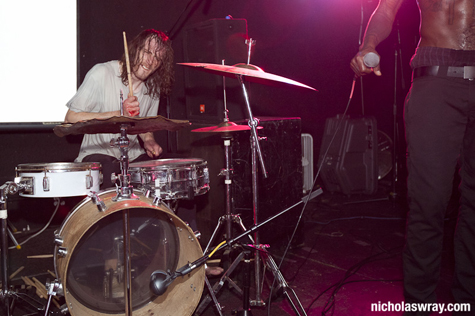
The Sunday prior to the Grimey set, Death Grips played a secret show at Press Club, a set that made its way to YouTube in record time. The Grimey announcement was as last-minute as it gets, with most of the curious anticipating a Davis house show as the unveiling of the mysterious Zach Hill project. The cloak was off entirely, as was frontman Stefan Burnett’s shirt as he stalked the stage, like any moment he might snap and start cracking skulls. No one was injured during the set, nor did a full-on mosh pit ever break out. The surprise was the rush to be on top of Death Grips without taking the stage–an instant embrace virtually unheard of for a local act. Burnett’s coined grunt of “Yuh” was mimicked on cue and other times in brief quiet moments, affirming his bark as the group’s battle cry. Sacramento is excited for its locally raised rap beast–enough to shed the cool, shed the cynicism, shed the apathy and get buck for 40 minutes in ToHo. It caught me off guard so much that I’m reluctant to mention it for fear it might backfire and curse the unabashed enthusiasm.

Whether we sustain our buzz in the home front or not, Death Grips is in takeover mode with or without us. This week (June 15), the group performs L.A.’s Low End Theory, a weekly melding of art and music held every Wednesday at The Airliner, a stage that made the careers of DJ Gaslamp Killer and producer/musician Flying Lotus. In the end, if Death Grips maintains an indifference to hype present within the music, it will always have a home in Sacramento. The nihilistic candor on tracks like “I Want It I Need It (Death Heated)” and “Spread Eagle Across the Block” boasts a lifestyle prevalent in Midtown yet to be captured sonically. I, for one, hope this is the beginning of many voice-shot nights shouting “Yuh” to come.

j27 Art Gallery
If you’ve driven through or walked down J Street past the 2700 block lately, you’ve more than likely noticed the new sign outside what used to be Papi’s Pizza that simply says, “Art.” Meet j27 Art Gallery, a brand new gathering space co-owned by area artists Susan Rabinovitz and Michael Shane. Rabinovitz, known for her hand-forged jewelry, met Shane, an abstract painter who also owns a shipping and delivery company, at the Sacramento Art Complex where they both had studios about a year-and-a-half ago. “We’d always discussed doing something together,” Shane said during a recent conversation with Submerge. “So about two months ago when I started looking at commercial space I called her up and said, ‘Are you still in?’ and she said, ‘Yeah!’ so we came over and looked at this space. We signed the lease two days later.” Shane pointed out that they are aiming to break the “Second Saturday only” mold and that they want to be “an everyday gallery.” Every weekend there will be something going on, not just on Second Saturdays, be it a live art exhibition, live local music, meet and great sessions with artists and more. Currently represented at j27 are paintings and jewelry from Shane and Rabinovitz as well as a slew of other regional artists’ work including abstract paintings by Gayle Rappaport-Weiland (June’s featured artist); photography from Monica Lunardi and Allister Oliver; fused glass art by Nicole Krohn; sculpture work by Molly Brown, Paula Swayne and Angela Ridgway; paintings from Donna Marie Sterpe as well as cartoonist Eric Decetis’ world-renowned work and much more. Shane pointed out that j27 is proud to be the only gallery selling Decetis’ original art, whose cartoons have graced the pages of countless publications. All in all, j27 has an excellent mix of art found in all sorts of mediums. It’s easy to get sidetracked when in the space, as there are so many eye-catching things to look at. “We’re trying to be very picky about the art that we hang,” Shane said. “We want to have an upscale environment and we want to be the place where people come to buy fine art. But, we want it to be a fun place too; we don’t want it to be stuffy. If you come in, you’re going to hear music, we’ll talk to you about the art, it won’t be dead cold and quiet. It’s important to carry that real high-end stuff, but you don’t have to make it, you know, cold and museum-like.” Learn more about j27 and the artists behind it at j27gallery.com or just stop in. They’ll be open every day starting at 11 a.m. (1 p.m. on Sundays).
-J. Carabba
The Detroit Cobras Scour the Archives and Revitalize Long-Lost Hits
The Detroit Cobras are good at what they do. So good, they kept the critical media scratching their collective temple as to why the band struck a familiar chord, but the origins were not quite traceable. Four albums and a gang of singles deep, the Cobras’ garage and R&B nostalgia earned them the company of their most-beloved songwriters and a friendship with a particularly notable Grammy Award-winning, Detroit-raised producer.
It is old hat to fuss with clever ways of calling the Cobras a cover band. The Detroit Cobras are a cover band. Don’t let them tell it with a fine slant. The good news is, they’re a band with exceptional taste rooted in the vaults of lesser known Ronettes, Irma Thomas and Otis Redding hits. Guitarist Maribel Ramirez sums it up with, “To me it’s not important whether you write or you don’t write, it’s that you come up with great songs.” The Cobras are far too rad to play your cul-de-sac soirée, Fire Department barbecue fundraiser or wedding reception. It leaves the covers of Fleetwood Mac’s “Don’t Stop” to the animatronic band in Chucky Cheese restaurants.
“We’ve never reported ourselves to be a cover band. It’s not like we’re doing Motown review and I’m coming out with my hair in a beehive doing Supremes songs,” lead singer Rachel Nagy said. “Once one critic found out, other critics started raving, but we never said we wrote them. It’s not a hidden issue.”
It’s been four years since Tried & True, making my first inquiry quite obvious–what’s the haps on a new record? Turns out, the Cobras are waiting on fellow Detroit native Don Was, a man whose production is well worth the delay. If the name is not ringing a bell, perhaps these will: Lyle Lovett, Iggy Pop, Elton John, Bob Dylan, Bonnie Raitt, Garth Brooks and The Rolling Stones.
“The whole Don Was thing is kind of nebulous right now. He’s a very busy man.” Nagy said. “We’re talking about maybe mid- to end of summer to start recording. We may even do it backwards now that all the hip kids are putting out singles. Just start putting stuff out as we record it.”
While the Cobras wait for Mr. Was to grace them with his time and expertise, we took to discussing the meat and potatoes of the Cobras’ next step in being the best darned (cover) band around. With the cat out of the bag and old songwriters coming forward at their shows, it’s an exciting new time for the band, in which perhaps an original or two might sneak into the tracklisting.
It’s been a while since the last Detroit Cobras record. What’s the motivation going into the new record?
Maribel Ramirez: Being able to record a little better. We make decent records, but we’d like to take it a little further than we already have–make it more powerful. We’ve done a decent job by ourselves. In talking to Don [Was], it’s something we both want to do.
Will there be a shift in the bands that influence the music?
MR: It’s digging deeper. It’s almost attitude-wise, you know what I mean. We’re a little more grown up and we still want to make a dance record, but dance by our definition.
Rachel Nagy: Was said to us, “Look, I won’t do this if I don’t know what to do. If I don’t understand this and don’t know what I can bring to you guys, I won’t try to fake through it or turn you into something you’re not.” And that’s what we needed to hear.
Does the band feel pressure of possible misrepresentation, considering the songwriting process is built upon previous works? Do you ever get approached by disgruntled fans or the original songwriters?
MR: You’d think we would have, but to tell you the truth, most people don’t know the records. People aren’t really going to come up to you and tell you negative things anyway. When we cover a song people go looking for it. Most don’t say, “Hey, I know that.” When we were in Europe, it was cool to see the effects of having done this. People come out and say, “Let me show you what I’ve got.”
In Los Angeles a person came to the side of the stage and said, “There’s a person here who says you covered one of their songs.” I remember thinking, “I thought most of them were dead?’ Who the fuck is standing at the door.” It was Jackie DeShannon [one of the first female singer/songwriters in rock ‘n’ roll]. We went to a little studio and wrote a couple of songs with her. One of the songs we wrote during that session I want to use on the next record. I at least want to give it a shot.
Have you ever had someone try to pull the wool over you and pretend to be related to one of the deceased musicians to get paid in some form?
RN: The closest thing that ever happened to that was Mickey Lee Lane’s brother. I don’t think we met him, but I think he sent us a letter. It was cool, but then died. The next thing you know we’re getting these long e-mails from his brother. He started on the whole, “Yeah, I actually wrote that and here’s some other stuff I wrote that I’d love if you guys would do.” It was very obvious that he hadn’t written anything.
The other music he was sending us was terrible. It was really bizarre shit like I don’t think we’ll be doing a dance remix of the blues anytime soon. Other than that, we’ve never really had anyone try and play us.
Considering many of these songs are obscure hits that are either out of print or impossible to find, has there ever been an interest to do more for the originals beyond the band’s interpretations of them? For example, a label that focuses on reissues or a compilation?
RN: We absolutely have the utmost respect, it’s one of the reasons we do what we do. But this is our personal jukebox. We get together, share each other’s weird records, drink some beer and play the songs we love and find fun. Other than that it was not supposed to be anything deeper.
I wouldn’t really call us collectors. I’ve lost so many records. It comes down to the difference between boys and girls. The girls run around, dance and have a good time, while the boys are the librarians discussing who begat who.
We’ll leave all the reissuing to those boys that are great at cataloging and remembering and not losing their records and not moving from a house and forgetting two boxes in the attic.
Detroit Cobras will perform The Blue Lamp on Thursday, June 9, 2011 at 9 p.m. Also appearing will be Girl in a Coma. Tickets are $12 in advance and can be purchased at Eventbrite.com.
Our good friends at Spanglish Arte (located at 905 23rd Street) are excited to be hosting the second annual Piñata Festival on Saturday, June 11, from 12 p.m. to 8 p.m. Sacramentans of all ages and backgrounds are invited to experience this free and ever-so-vibrant event set to take place on 23rd Street between J and I streets. It’s a unique celebration of piñatas through art, live music, food and free workshops. The entire block will be lined with custom colorful and avant-garde piñatas, vendors of all sorts (folk art, custom jewelry, culturally infused food, etc.) and Papel Picado to “not only bring out the mood of celebration, but it will also create a vibrant experience for everyone who attends,” said Spanglish Arte owner Mari Arreola in an official press release. Local artist Danny Schieble, known for his “Tapigamy” sculptures, will be onhand, creating his own piñata masterpiece for spectators to view. Also, for this year’s event, Arreola has invited private individuals, organizations and local businesses to sponsor or bring out their own piñata in the shape of their logo to enter it in a special contest. A portion of the proceeds from every sponsored piñata will benefit the Washington Neighborhood Center. There will free piñata workshops throughout the day, too, if you’re feeling crafty. Basically, this is the block where you’ll want to spend your time this Second Saturday, as it will have it all: art, live music, dancing, great food, good company, what else could you ask for? For more information about Spanglish Arte, visit Shopspanglish.com
Fat Face inside the new Bows and Arrows
1815 19th Street, Sacramento
I’d exercise caution when saying to your friends, “Get your Fat Face on!” They might take it the wrong way. Preface it by letting them know that it’s actually a good thing and you’re not attacking their winter waistline. Fat Face is the name of Jaymes Luu’s sandwich and gourmet popsicle business that has recently closed shop in Davis and will now be take residence in the new Bows and Arrows space (1815 19th Street, Sacramento). Luu describes the name of the business as a funny term for enjoying really good food, but in very humble way. It’s a term that she and her friends came up with that’s a very fitting definition, considering that Luu’s food is both good and humble.
On the Fat Face website, Luu encourages customers trying her popsicles to be “adventurous” and to “challenge their palates.” This might seem like a disclaimer for the out-there kind of flavors, but who wrote the rules on what a popsicle should be, anyway? Luu has been pushing the boundaries with her frozen confections, and the boundaries have never tasted so good. Among some of her more popular flavors is the Kaffir limeade and avocado, an interesting concoction for the title of “most popular.” Apparently fans of Fat Face have taken the challenge.
Fat Face’s previous location was on L Street in Davis, a small space where she not only served her signature popsicles, but also cranked out delicious sandwiches to boot. Grilled cheese with beer poached figs, smoked salmon, cola braised pork sandwiches or asparagus-filled breakfast “sammies” are some of the fun and sometimes wonky menu items that can be found at Fat Face. Ingredients are seasonal and specials can change on a whim, depending on who Luu has heard a suggestion from that day.
“[I get suggestions from] a lot of people I work with or customers will come up and be like, hey I think you should make this-and-this popsicle,” says Luu. “That will spark me to make new flavors.”
Luu is currently working on a mango and sticky rice popsicle and one of her newest flavors is something she calls the “bacon and egg.” Luu describes it as a “very yolky vanilla custard with a ginger bacon caramel.”

At the new location, Luu plans to extend her menu by playing off of the beer and wine list that Bows and Arrows owners Trisha Rhomberg and Olivia Coelho have been piecing together. The potential for crafting some small plates has sparked an interest for Luu, and she’s already got some ideas in mind.
“I want to have a pickle plate, fun popcorn; I’m trying to have more fun bar food like olives, but figure out how to make that more interesting than just olives,” says Luu.
When Luu decided to collaborate with Rhomberg and Coelho, she was drawn to their commitment to the project and how serious they were about making it all come together. They already had a building locked down, a kitchen in place and agreed to take on the build out. If all that wasn’t appealing enough, Luu also just simply liked what the whole thing was about.
“I appreciate their vision for what they want to do and what they want to bring; a community they want to create with their art stuff and their music,” says Luu.
The feeling was mutual.
“We went to eat lunch at Fat Face in Davis…walked in and loved everything about it. Super simple, sophisticated food that was local, seasonal, farm to table, scrumptious ingredients–really interesting flavors mixed together. The presentation was really humble but it was really good food,” says Coelho.
There’s something about Fat Face that Sacramento just hasn’t seen yet. It’s hard to put a label on and difficult to pigeonhole or compare with another cuisine. With the amount of support that was shown by Sacramento at the first annual Mobile Food Truck Festival, it’s clear that we love walking up to a truck to get something tasty. And wasn’t that idea born from the jingle of the neighborhood ice cream truck or paletero cart? Luu herself was at that festival, conducting a sort of Sacramento dry run, and her line was as long as the rest. Looks like we’re in for a fun summer. Now go get your Fat Face on.

